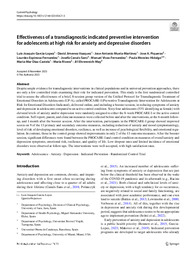Por favor, use este identificador para citar o enlazar este ítem:
https://hdl.handle.net/11000/36133Registro completo de metadatos
| Campo DC | Valor | Lengua/Idioma |
|---|---|---|
| dc.contributor.author | Garcia‑Lopez, Luis‑Joaquin | - |
| dc.contributor.author | Jimenez-Vazquez, David | - |
| dc.contributor.author | Muela-Martinez, Jose-Antonio | - |
| dc.contributor.author | Piqueras, Jose A | - |
| dc.contributor.author | et al. | - |
| dc.contributor.other | Departamentos de la UMH::Psicología de la Salud | es_ES |
| dc.date.accessioned | 2025-03-26T09:22:12Z | - |
| dc.date.available | 2025-03-26T09:22:12Z | - |
| dc.date.created | 2023-12-14 | - |
| dc.identifier.citation | Current Psychology, Volume 43, pages 15484–15498, (2024) | es_ES |
| dc.identifier.issn | 1936-4733 | - |
| dc.identifier.issn | 1046-1310 | - |
| dc.identifier.uri | https://hdl.handle.net/11000/36133 | - |
| dc.description.abstract | Despite ample evidence for transdiagnostic interventions in clinical populations and in universal prevention approaches, there are only a few controlled trials examining their role for indicated prevention. This study is the frst randomized controlled trial to assess the efectiveness of a brief, 8-session group version of the Unifed Protocol for Transdiagnostic Treatment of Emotional Disorders in Adolescents (UP-A), called PROCARE-I (Preventive Transdiagnostic Intervention for Adolescents at Risk for Emotional Disorders-Indicated), delivered online, and including a booster session, in reducing symptoms of anxiety and depression in adolescents compared to an active control condition. Sixty-four adolescents (53% identifying as female) with elevated levels of anxiety and/or depression were randomly assigned to either the 8-week PROCARE-I or the active control condition. Self-report, parent, and clinician measures were collected before and after the interventions, at the 6-month followup, and 1 month after the booster session. After the intervention, participants in the PROCARE-I group showed improved scores on 9 of the 13 primary and secondary outcome measures, including reduction of anxiety and mood symptomatology, level of risk of developing emotional disorders, resilience, as well as increase of psychological fexibility, and emotional regulation. In contrast, those in the control group showed improvements in only 2 of the 13 outcome measures. After the booster session, signifcant diferences were found between the PROCARE-I and control condition on measures of overall anxiety and depression symptoms, emotional risk, resilience, and quality of life. Low dropout rates and limited incidence of emotional disorders were observed at follow-ups. The interventions were well-accepted, with high satisfaction rates. | es_ES |
| dc.format | application/pdf | es_ES |
| dc.format.extent | 15 | es_ES |
| dc.language.iso | eng | es_ES |
| dc.publisher | Springer | es_ES |
| dc.rights | info:eu-repo/semantics/openAccess | es_ES |
| dc.rights.uri | http://creativecommons.org/licenses/by-nc-nd/4.0/ | * |
| dc.subject | Adolescence | es_ES |
| dc.subject | Anxiety | es_ES |
| dc.subject | Depression | es_ES |
| dc.subject | Indicated Prevention | es_ES |
| dc.subject | Randomized Control Trial | es_ES |
| dc.subject.other | CDU::1 - Filosofía y psicología::159.9 - Psicología | es_ES |
| dc.title | Efectiveness of a transdiagnostic indicated preventive intervention for adolescents at high risk for anxiety and depressive disorders | es_ES |
| dc.type | info:eu-repo/semantics/article | es_ES |
| dc.relation.publisherversion | https://doi.org/10.1007/s12144-023-05421-3 | es_ES |

Ver/Abrir:
2023_Effectiveness of a transdiagnostic indicated preventive intervention for adolescents at high risk for anxiety and depressive disorders.pdf
722,76 kB
Adobe PDF
Compartir:
 La licencia se describe como: Atribución-NonComercial-NoDerivada 4.0 Internacional.
La licencia se describe como: Atribución-NonComercial-NoDerivada 4.0 Internacional.
.png)